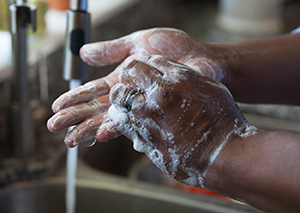A
B
C
D
E
F
G
H
I
J
K
L
M
N
O
P
Q
R
S
T
U
V
W
X
Y
Z
Topic IndexLibrary Index
Click a letter to see a list of conditions beginning with that letter.
Click 'Topic Index' to return to the index for the current topic.
Click 'Library Index' to return to the listing of all topics.
Managing a Poison Ivy, Poison Oak, or Poison Sumac Reaction
If you come in contact with urushiol
Sap oil (urushiol) is contained in poison ivy, poison oak, or poison sumac plants. If you think you may have come in contact with it, it's important to wash the affected part of your skin as soon as possible. This is to remove the sap oil or help prevent further spread.
-
Wash the affected areas with degreasing soap (such as dishwashing soap) or rubbing alcohol and lots of cool water as soon as you come into contact with a poisonous plant.
-
Undress, and wash your clothes and gear as soon as you can.
-
Be sure to wash any pet that was with you.
Taking these steps can help prevent spreading sap oil to someone else. The rash is caused by the sap oil. Once you have washed yourself and your clothing, the rash itself can't be spread to others. If you have a rash, but aren't sure if it's from one of these plants, see your healthcare provider.

To soothe the itching
Your skin may react to poison oak, poison ivy, and poison sumac within hours to a few days after contact. Listed below are some common home care treatments. If these aren't effective in easing symptoms, call your healthcare provider. They may advise other treatments. These may include prescription medicines.
-
Don’t scratch or scrub your rash. Not even if the itching is severe. Scratching can lead to infection.
-
Bathe in lukewarm (not hot) water. Or take short cool showers to ease the itching. For a more soothing bath, add oatmeal to the water.
-
Use over-the-counter antihistamines that are taken by mouth (oral). These include diphenhydramine. You can buy these at the grocery store or pharmacy. Talk to your provider or pharmacist for more information on antihistamines. They may make you sleepy or slow to react. So it's best not to take these during the day or when driving.
-
Use over-the-counter treatments on your skin. These include cortisone creams and calamine lotion.
How your skin may react
A mild rash may become red, swollen, and itchy. The rash may form a line on your skin where you brushed against the plant. If you have a severe rash, your itching may get worse. Or your rash may blister and ooze. If this happens, get medical care. The fluid from your blisters won't make your rash spread. With or without medical care, your rash may last up to 3 weeks. In the future, try not to come in contact with these plants.
When to call your healthcare provider
Call your healthcare provider right away if any of these occur:
-
Your rash is severe
-
The rash is sore or has yellow scabs and has pus coming from the blisters.
-
The rash spreads beyond the exposed part of your body or affects your face or genitals.
-
The rash doesn't clear up in a few weeks
Call 911
Call 911 right away if you have any of these:
Online Medical Reviewer:
Chris Southard RN
Online Medical Reviewer:
Rita Sather RN
Online Medical Reviewer:
Ronald Karlin MD
Date Last Reviewed:
3/1/2024
© 2000-2025 The StayWell Company, LLC. All rights reserved. This information is not intended as a substitute for professional medical care. Always follow your healthcare professional's instructions.